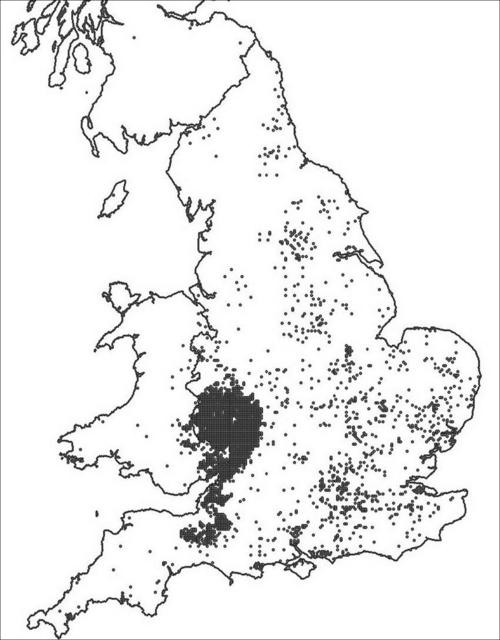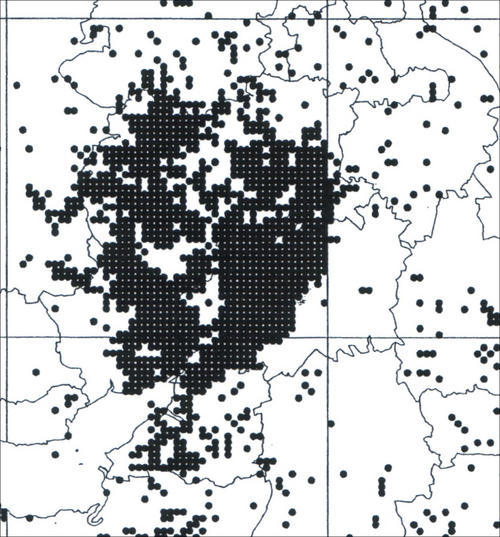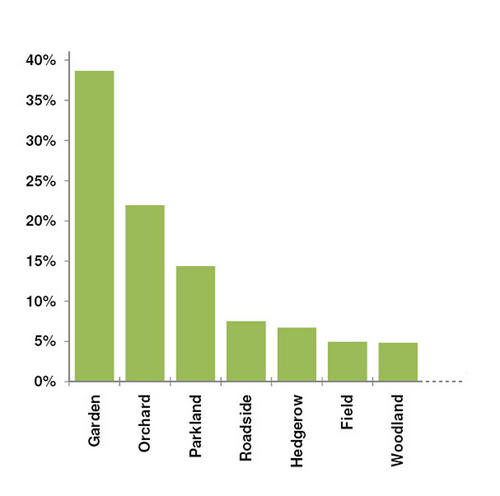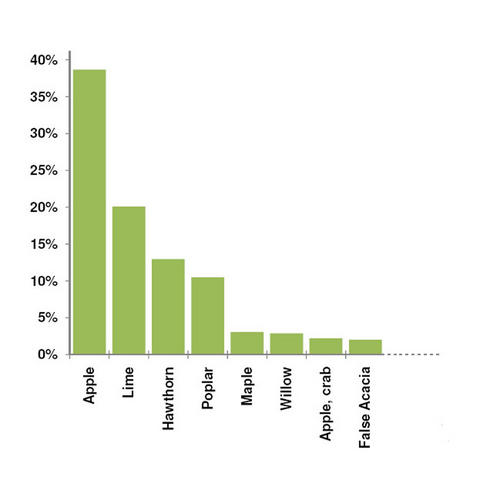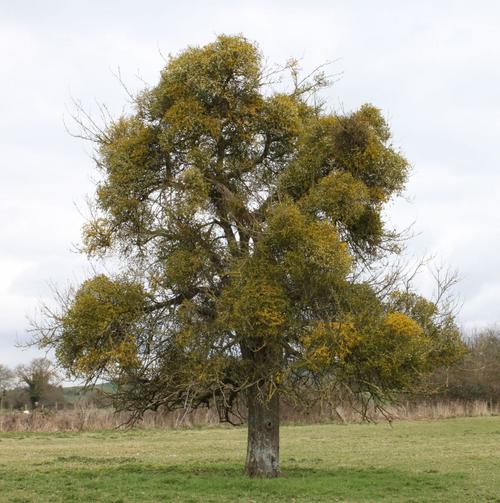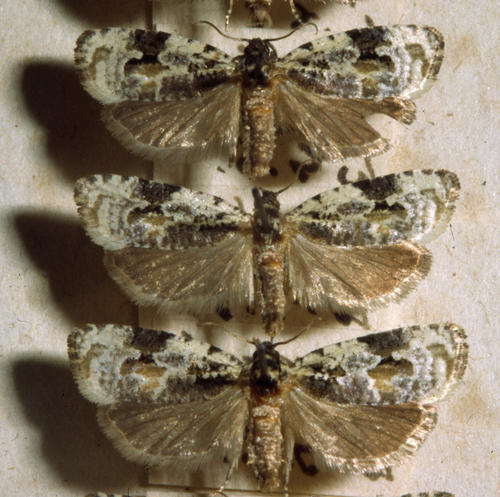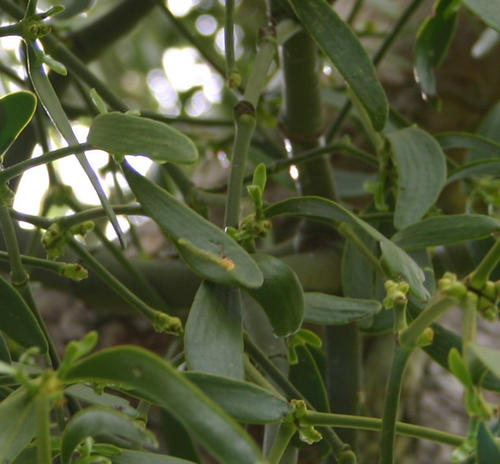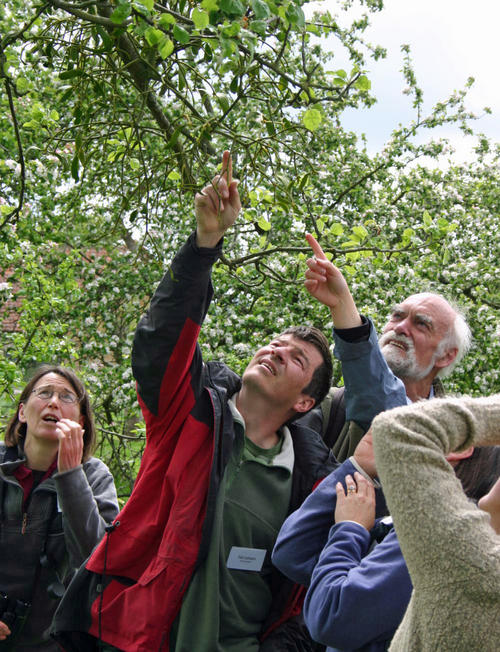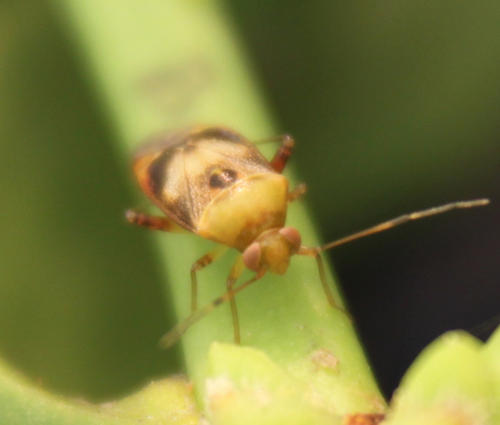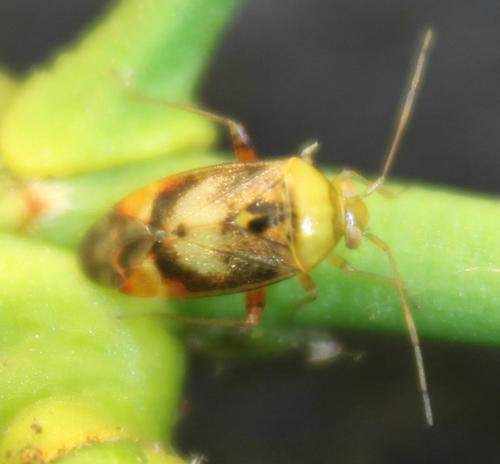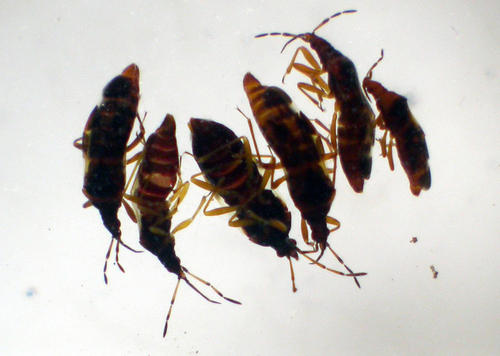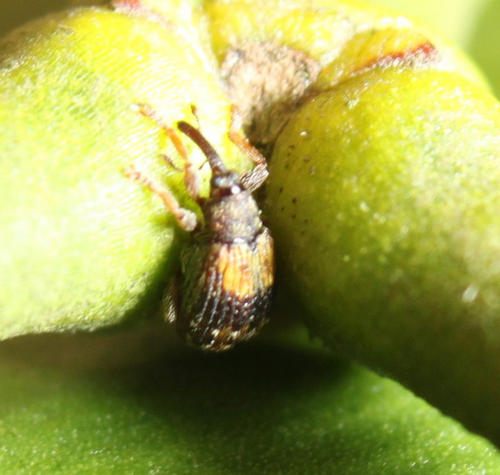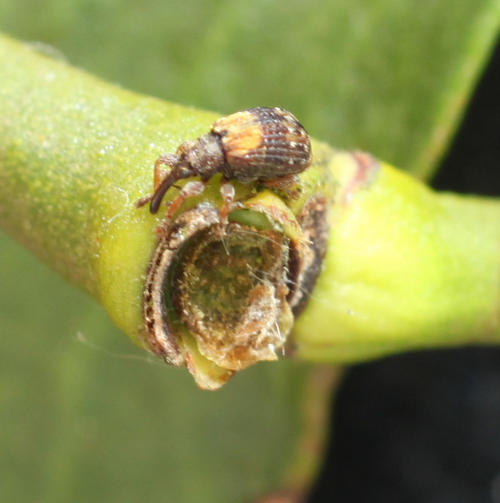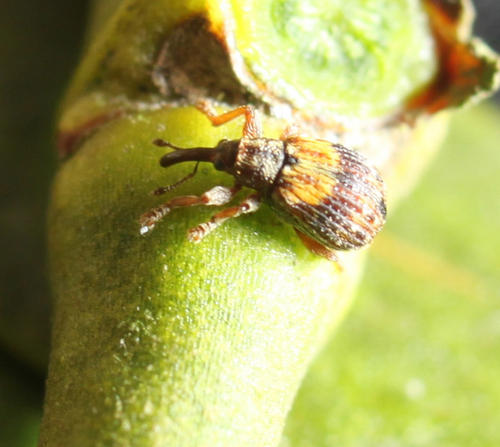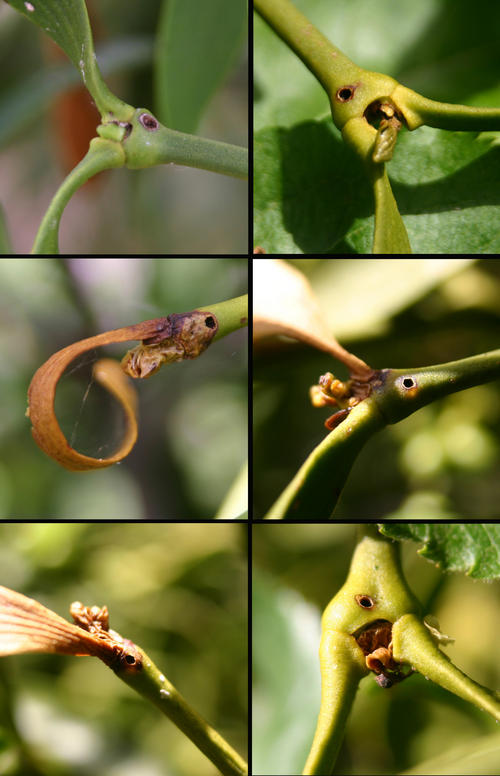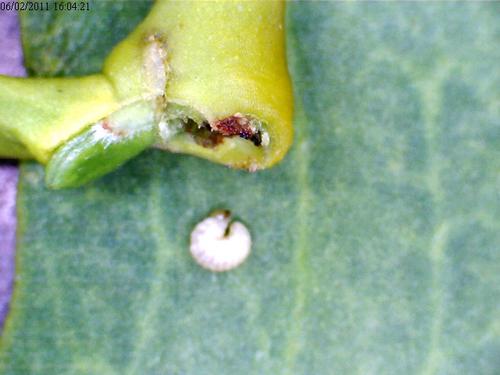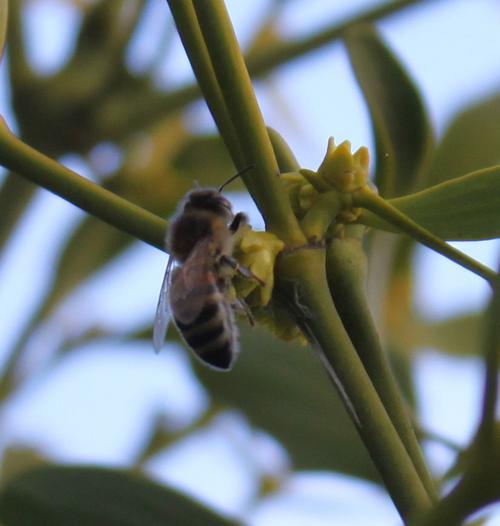Mistletoe and mistletoe insects, overview and observations from 2010
Jonathan Briggs - including pictures © unless otherwise stated.
jonathanbriggs@mistletoe.org.uk
This account of mistletoe Viscum album and its associated insects reprises and updates the account I gave to the Worcestershire Recorders Annual meeting in March 2010. The text draws heavily on a recent paper I wrote for the Gloucestershire-based CNFC (Briggs 2011) with some updated observations from this winter. Hopefully it will stimulate more mistletoe bug, moth and weevil hunting in Worcestershire this summer; our mistletoe insects are an interesting little group, most are (relatively) easily spotted, and there should be plenty of them in Worcestershire.
I’ll start with a quick review of mistletoe itself, with notes on its distribution, hosts and habitats, as understanding those is essential if the invertebrates are to be fully appreciated.
Mistletoe distribution
Britain is at the northern edge of mistletoe’s distribution in Europe, with mistletoe occupying slightly more northerly latitudes here than it does in mainland Europe (it is almost entirely absent from Scandinavia). This suggests a climatic limitation to its natural range – a concept supported by a brief glance at its UK distribution where there is a clear bias to the SW Midlands area.
Within Britain this distribution is often simplified as being the ‘Three Counties’ of Worcestershire, Herefordshire and Gloucestershire and is often assumed to be a result of association with apple orchards. But looking at an enlargement map (both maps are derived from the BSBI/Plantlife 1990s national mistletoe survey) it becomes clear that the distribution more closely matches the lowlands in and around the river corridors of the Severn, Avon, Wye and Usk, straying well into Gwent and down into Somerset. Obvious geographical constraints seem to be altitude – the Cotswold escarpment clearly forms the eastern boundary, with the southern Welsh uplands forming the western side and the Clee Hills and the Birmingham plateau forming the northern limit.
This distribution has been known, and commented on, throughout botanical recording history, but exact climatic factors are difficult to define, though it is thought that winter and summer temperature maxima and minima are important. But, as the maps show, the species can survive almost anywhere in southern Britain, so it’s obviously not quite so simple. There are, incidentally, several relatively new accounts of some of the eastern counties’ mistletoe colonies spreading further in recent years, so something may be changing (some possible factors are discussed briefly below).
Habitats and hosts
The habitat and host preferences of mistletoe are just as peculiar as its distribution. As a parasite of tree branches the species is, obviously, dependent on suitable host trees for its survival, but it really requires those trees to be in fairly open habitats, and it does not thrive in a woodland environment. In a pre-clearance Britain it would probably have been restricted to trees on edges of clearings, alongside rivers and on the open habitats of steep slopes. In our more man-made Britain the vast majority is found on trees in gardens, orchards, parks, churchyards, field margins and roadsides. The implication is that it would be much less frequent without these habitats, though its distribution might well be similar.
The pattern of preferred hosts is intriguing, with most mistletoe on man-made hosts (i.e.hybrids and varieties created through horticulture). Cultivated apple and hybrid limes support most of our mistletoe – choices which correlate quite well with the garden, orchard and parkland habitats. This host preference is marked, with huge proportions on those few tree species, but it is worth stressing that mistletoe will grow on many hundreds of different hosts too. Its natural (pre-clearance) hosts would probably be dominated by hawthorns, whitebeams, and white willows.
Conservation issues arising so far
The association of mistletoe with apples, orchards and the three counties has inevitably led to a strong belief that these are all interlinked, and that the future of mistletoe depends on the future of apple orchards. This is an oversimplification, but it is an important factor.
The 1990s BSBI/Plantlife Mistletoe Survey set out to investigate whether mistletoe was actually threatened by apple orchard loss. Results showed that whilst mistletoe quantity might be reduced through loss of orchards, the distribution of mistletoe was much the same as it had ever been, with possible increases in some areas. The ‘core’ area in the south-west midlands did however have the greatest range of hosts and habitats for mistletoe –its habitat preferences become even more dominated by gardens and parks further east, north or south.
This all tends to strengthen the view that it is here because the location suits it, not because there are/were lots of apple trees. An additional point of course is that apple growing areas occur, or used to occur, in many other parts of the country, but these other apple areas have no significant association now, or historically, with mistletoe.
The whole mistletoe conservation issue is, therefore, a little confusing. It is undoubtedly rare over most of Britain, and it is locally threatened in some areas. In those areas (primarily in the east) several local Biodiversity Plans have included direct action (e.g. deliberate planting) to encourage mistletoe. In other areas (again mostly in the east) it is reported to be locally increasing, apparently without intervention.
But here in the SW Midlands it seems to be still common, and there is no real threat to its continuing existence in the wider countryside. Except in orchards. And that’s where most of it is, in terms of quantity. Orchard loss is continuing despite many local campaigning groups raising awareness. Their efforts can save exemplary farm and community orchards but the loss in the wider countryside has either happened or is continuing.
This implies that we have already, and probably will continue to experience for the next few years, a reduction in the amount of mistletoe. Does this matter or not? In economic terms it might, as most Christmas mistletoe is harvested from orchards. The famous mistletoe auctions at Tenbury Wells are supplied almost entirely from apple orchards. So we seem likely to have a smaller mistletoe crop in future.
But the Tenbury mistletoe auctions always seem to have plenty of mistletoe – so is the crop really threatened? This is another confusing area, and there are no statistics to help, but it does seem reasonably likely that the auctions are being largely supplied by excessive growths of mistletoe in now-neglected orchards. In other words there might be a short-term glut of mistletoe available from older, senescent orchards, which makes current availability seem good. But this is an unsustainable situation – once those old trees have gone the harvestable quantities will surely reduce.
Conservation issues for associated species
So there might be some economic impacts for mistletoe cropping with continuing local apple orchard loss. What are the wider conservation implications? Loss of abundance might ‘only’ be a landscape issue in simple conservation terms, as long as the species remains common on other hosts and habitats locally but there may be some side-effects, particularly for the obligate insects, and the specialist birds, of mistletoe. The current, but ephemeral, phenomenon of excessive mistletoe growth on older apple trees may also have implications for these species.
The obligate insects of mistletoe are an odd little group. In the 1990s just four species were known in the UK, all overlooked and considered scarce or rare. Since then two more have been discovered (both by National Trust survey teams) and there may be more to find in future (several dozen are known from Viscum album in mainland Europe).
Their national status, and conservation needs, have only recently been given any attention, helped along by the attention given to mistletoe following the 1990s studies and the inclusion of one of them, the moth Celypha woodiana, on the UK BAP Priority Species list in 2008. But despite this recent attention, little is known about their biology as, inevitably, most recording is just that, recording. So there is much potential for investigation (and more recording too) particularly in terms of habitat and life-cycle needs. Do these insects thrive best on crowded mistletoe? Or on well-spaced clumps? Will a loss of abundance, with inevitably increased isolation of some colonies, be a problem or not? Is there a preference for male or female mistletoe? Older or younger plants? Edge-grown plants on the ends of tree branches, or denser growths further inside the canopy? And, not least, is the pre-occupation with sampling mistletoe on apple trees (where mistletoe is relatively accessible) resulting in flawed assumptions that these species are ‘associated’ with apple orchards, when they might be as common, or even more frequent, on mistletoe in other hosts/habitats?
A summary of each of the six species, drawn from my recent CNFC account (Briggs 2011), so with a bit of a Gloucestershire bias, is presented below. (Note that this is not a full assessment of current records.)
The six species are; one moth (the Mistletoe Marble Moth Celypha woodiana), three sap-sucking bugs (Cacopsylla visci, Pinalitus viscicola and Hypseloecus visci,), one predatory bug (Anthocoris visci - it feeds on the other bugs) and one beetle (the Mistletoe Weevil Ixapion variegatum). There are also several non-obligate insects using mistletoe too – I’ve added some points on pollinators to this account.
Celypha woodiana (Mistletoe Marble Moth)
This small tortricid moth was originally discovered in 1878 by John Wood of Tarrington near Hereford. It was known to be associated with apple orchards, but its larval food plant remained unknown until it was found to be a leaf-miner of mistletoe leaves in 1892.
The moth remained fairly obscure, with only occasional records across Herefordshire, Worcestershire, Gloucestershire, Gwent, Somerset, and Warwickshire, until it was added to the UK BAP in 2008. This has led to considerably more attention, with a 2009 national survey undertaken by Butterfly Conservation, part-funded by the National Trust and Natural England.
Finding the moth itself is difficult (though it does come to traps) so most survey effort concentrates on spotting the leaf-mines of the larvae. These begin as small comma-shapes, following hatching in late summer, and remain unchanged throughout the winter. In spring and summer they expand to a larger blister mine that can be spotted from the ground. This takes practice, as James McGill, who undertook the 2009 survey (McGill, 2009) found out. As part of that project he organised training sessions for others, showing how to look for these mines with binoculars.
McGill also reports on the difficulty of differentiating other tortricid moths that may be seen on or near mistletoe. Most are web-spinning, binding leaves together, but confusingly, Celypha can also sometimes spin leaves together, so larval appearance sometimes has to be used too.
McGill concentrated on apple orchards, visiting 34 sites across mistletoe’s core area. Several new sites were found, but some old sites failed to produce records. Of all the sites visited the best, in terms of number of host trees showing signs of the moth, was an orchard at Sandhurst, Gloucester, with the moth found on mistletoe in 10 trees.
The preoccupation of the 2009 survey with apple orchards is unsurprising but also slightly frustrating, as it would be useful to see whether the moth is as common on mistletoe on other hosts. Recording effort has always been biased towards orchards because of the original 1878 association with orchards, and the ‘official’ description of the moth in Bradley et al (1979) stating it is ‘apparently restricted to old apple orchards in the west of England’.
Some records from the 2009 survey hint at the importance of other hosts; the highest number of actual mines seen on one host tree during the survey was 27, on a hawthorn on the Somerset Levels. The most mines seen on apple were just 10, with most scoring well below that.
Other recent records give further information. There are Worcestershire records on mistletoe on Rowan (Simpson 2005). Further south in Gloucestershire Robert Homan has been recording it on mistletoe on hawthorn at Chaceley (Homan 2007), and also on hawthorns along the banks of the Coombe Hill Canal (2005 to 2010) and on hawthorn in Hyde Lane, Cheltenham (2005 to 2007).
It does seem likely that other mistletoe hosts may be just as important as apple orchards, and possibly more so. McGill noted that there seemed to be more mines on higher mistletoe growths, on the edges of the host tree. Most mistletoe outside orchards is in exactly this position, so if the moth prefers mistletoe like that, it must surely find a lot of potential in non-orchard trees. Of course there is undeniably more mistletoe in orchards, and so greater potential for the moth, but McGill also suggests that orchards with too much mistletoe seemed to have fewer moths; another hint that mistletoe in the wider countryside might be just as important.
Cacopsylla visci (Psylla visci)
This psyllid seems to be the most neglected of our mistletoe insects, partly because it is similar to so many others (e.g. Psylla mali, a specialist on apple). It has been recorded from across mistletoe’s core area, with records suggesting it is almost always found if it is actually looked for. Hollier & Briggs (1999) looked for it and recorded it in at all sites when sampling in Painswick, Kemerton and Little Marcle. Green & Meiklejohn (2000) found it readily at Little Comberton, and Price (1987) found it easily when looked for in Warwickshire.
Though often assumed to be limited to ‘our’ area it is surprisingly widespread, and has been recorded across the country (e.g. Badmin (1985) bred large numbers from mistletoe that had fallen from a Field Maple near Sittingbourne). More intriguingly it has recently been recorded as a new Norwegian species, despite only one sizeable mistletoe population within Norway (Hansen & Hodkinson, 2006). This raises the interesting question of how the species can spread to such an isolated population of its foodplant.
Pinalitus viscicola (Orthops viscicola, Lygus viscicola)
There’s an interesting recorder-challenge back-story for this one, which also links to the Hypseloecus (see below). In 1888 two new species of mistletoe bug were described from apple orchards near Paris, and Douglas (1889a) challenged British entomologists to find them. The Woolhope Naturalists Field Club in Herefordshire rose to this challenge and managed to describe one of the two, Pinalitus viscicola, as ‘common’ by the summer of 1889 (Douglas 1889b). They did not (then) find the other species.
At the same time, also in response to the challenge, previously collected but hitherto unidentified specimens of this species from mistletoe in Dorset and Norwich were also reported (Douglas 1889c). The implication was clear; this species had been overlooked, but was actually surprisingly common on mistletoe.
Today this little bug is still under-recorded, but still easy to find. Most records mention it as ‘frequent’. For example Hollier & Briggs (1999) found it in large numbers at Painswick, Kemerton and Little Marcle, and Price (1987) found it easily on mistletoe in apple in churchyards, allotments and gardens in Warwickshire. It occurs outside of mistletoe’s core area too; Nau (1985) recorded it from mistletoe on a Field Maple in Bedfordshire.
My own observations in 2010, at various sites in the Haresfield area of Gloucestershire suggest it is very abundant, with instars becoming very obvious from mid-May onwards, and numerous mature adults from early June, with a second flush of adults in late August and September.
The species overwinters as eggs, with instar development in spring, so it seems likely my second flush was a second generation that had matured quickly in June-July. Having found that this is a surprisingly easy species to find and monitor I hope to do some more detailed monitoring this season.
Anthocoris visci
This is the oddest of our mistletoe obligates, for it is a predatory species. It obviously does not rely directly on mistletoe, and instead is assumed (though with little actual evidence) to specialise in feeding on the other mistletoe bugs, especially the psyllid.
It was described as a new species by Douglas (1889d), after being collected from mistletoe near Hereford. Adults appear in August to September and are thought to overwinter under bark and lay eggs in spring. The larvae, said to be a distinctive orange-red, are also carnivorous. The adult also has some red colouring, but in general appearance is very similar to other Anthocorid bugs (the so-called Flower Bugs) and so it can easily be confused with other, commoner, species. In 2010 I observed several Anthocorids on mistletoe, including some feeding on psyllid bugs, but none were quite right for A.visci.
It is officially listed as ‘Notable’ with threats listed as destruction of old apple orchards. This is despite little knowledge of it on mistletoe outside apple orchards. Most records are in the mistletoe core area but it has also been spotted as far afield as Dorset, Denbigh and Norfolk. Like the other bugs it is fairly easily detected when looked for by experts but that isn’t very often, possibly due to lack of opportunity; Nau (1985) recorded it from mistletoe from the top of a poplar tree, but he could only sample that because it blew down in a gale.
Hypseloecus visci
This is second of the two species discovered near Paris in 1888 Douglas (1889a), but this is the one the Herefordshire naturalists failed to find in 1889 (see Pinalitus viscicola above). It may have been here all along, or may be a new arrival, but it wasn’t actually found in Britain until 2003, when the National Trust Biological Survey team found it in Somerset (Gibbs & Nau 2005).
The NT team found it on mistletoe in apple orchards in late July at two Somerset sites. Records since have been sporadic but scattered, and they include ‘large numbers’ taken on mistletoe in Bushy Park, Middlesex and ‘large numbers’ attracted to a moth trap in Hampshire (Denton 2004 and Gibbs & Nau 2005).
These latter observations suggest a wide geographic spread, well beyond the core area, and early confirmation on a variety of hosts (at Bushy Park the mistletoe is on limes and hawthorns, not apple). It is not at all clear whether this is a recent arrival or not but it certainly seems widespread. In 2010 I observed several bugs looking very like Hypseloecus visci on mistletoe in Gloucestershire sites but these were formally identified.
Ixapion variegatum
This is another new arrival, or at least a new discovery, first recorded in Britain in 2000 by the National Trust team on mistletoe on apple at Brockhampton, Herefordshire. It has subsequently been recorded in Worcestershire, Gloucestershire and Monmouthshire.
As with Hypseloecus visci we have no real knowledge of whether this is a new arrival or not. Foster et al (2001), describing the new discovery in 2000, suggest that this species is probably ‘a long-established but overlooked representative of the British fauna rather than a recent arrival’. It is a very small weevil, about 3mm long, so could be easily overlooked. On the other hand it is very distinctive, so if found should surely have been readily spotted as unusual.
Foster et al (2001), reviewing European data for this species, suggest that it occurs at low densities (easily missed?) and appears to increase when mistletoe is perhaps under stress, perhaps on host trees that are dying. This association with ‘stressed’ mistletoe is also reported by others (e.g. Green & Meikelejohn 2004).
My own observations in the Stroud area in 2010, summarised in the table below, suggest that the species is very easy to observe in mistletoe without beating, and so it should be relatively easy to find and to study. Some populations I found were very numerous. Furthermore, rather than choosing stressed mistletoe, the weevil seemed to be, in effect, the cause of the stressed mistletoe. Eggs are laid into mistletoe stems just below the terminal bud (which, by late summer, is next year’s flower bud), and the larva develops within the stem before emerging as an adult later in the summer. One particular mistletoe clump I observed started the year looking healthy, but with nearly all its terminal buds dying after weevil infestation, was looking very stressed by August.
Over the winter I noticed that some of the dead terminal buds did not, yet, have an exit hole. Dissection of these revealed a fairly mature sized larva within the stem, presumably overwintering and due to emerge in spring.
| Dates/period | Comments | |
| Adults present | 25th June to 9th September | Continually present at one or more of the sites visited |
| Mating observed | 2nd July, 22nd and 26th August | |
| Feeding observed | July to August | Probing/feeding stems, and leaves, resulting in a speckling of small brown dots on the leaf surfaces |
| Egg-laying | Assumed in early July | Not definitely observed, but adults probing around areas below terminal buds assumed to be preparatory to egg-laying |
| Adult emergence | June onwards | Exit holes observed in increasing numbers from June. Most single, a few double. Observed in vitro by taking distressed but intact shoots indoors – emergence occurred within 2 days. |
| Die-back of infested terminal buds | June onwards | Some distress to terminal leaves and buds observed before holes appeared – the degree of dieback increased after emergence. Most buds with dieback showed an emergence hole by August. Dieback in new season growth observed in August, implying development of second generation. |
| Overwintering larvae | Investigated in February | A few dead terminal buds without an exit hole were dissected, and a mature-size larva found. |
The weevil’s impact on terminal buds isn’t necessarily just a curiosity. It may imply that these weevils do not ‘require’ stressed mistletoe, as assumed by some recent authors. Some suggest that this ‘need’ makes a management case for retention of stressed (ie old, senescent,) mistletoe on overgrown apple trees. But that might not be the case at all. It also has implications for the argument over whether the weevil is native and overlooked or a new, spreading, arrival. If the latter is true then we might, perhaps, be seeing the spread of a damaging species, which is destroying mistletoe flower buds and so could have economic impacts for the mistletoe trade.
Pollinators
Mistletoe is an early flowering species, with flower buds (those terminal buds damaged by the weevils) developing in late summer, ready to open in February. Male and female flowers are produced on entirely separate plants, though they sometimes grow in such close proximity (sometimes one is epi-parasitic on another) that it seems like one growth exhibits both sexes.
Despite being small and green these flowers are insect-pollinated. The exact species are, not surprisingly, rather poorly documented, but if you visit a mistletoe-laden tree on a sunny day in February or March you will always see insect activity, mostly small flies (Dasyphora etc) around the flowers. Sampling is difficult unless they are low growths.
Bees, including honey bees, also visit the flowers, and this is especially noticeable in mistletoe-rich orchards where there are also bee hives. It is not known how significant this early resource is for insects but it would be interesting to gain more information on the pollinators. Too late now for 2011, but a challenge for 2012?
Scarcity v obscurity
As well as the insect habitat requirement questions mentioned above, the most obvious question for the insects is are they really scarce/rare, or are they simply overlooked? Only much more recording effort can answer this. Some (notably Cacopsylla and Pinalitus) seem common when looked for, so rarity for them at least might not be an issue.
The biggest problem for recording is, of course, access. Most mistletoe grows too high to be sampled. Which is why there is that apple orchard bias in the records. We really do need more recording from mistletoe outside orchards, and on all hosts. Gardens are a good starting point – most garden mistletoe is easily accessible, and though much is on apple there is also plenty on other hosts, particularly other rosaceous shrubs and trees, but also many others like Acer, Salix, or even oddities like Robinia. Understanding how these insects use mistletoe in the wider environment may be particularly important as apple orchards continue to decline.
Associated birds and climatic factor
Lastly, it’s worth a quick mention of mistletoe’s bird vectors, and briefly comment on review climate change issues.
The single (but often polyembryonic) seed in each mistletoe berry can only distributed by birds, and not many species of birds take an interest in them. The white, extremely sticky, berries are either overlooked (not being red, blue or black) or are disliked (because of their stickiness) by most birds. Only some thrushes, primarily Mistle Thrushes (Turdus viscivorous) and a few other relatively unusual species (e.g. Waxwing Bombycilla garrulus) take them regularly. The thrush usually swallows a lot of berries before excreting the seeds, still in a sticky slime. This string of seed-laden slime will stick onto a host branch and any seed that is contact with the branch can germinate. But most seeds end up dangling in the slime string and won’t survive.
The dynamics of this situation have been changing in recent decades with increasing number of overwintering Blackcaps, Sylvia atricapilla, across southern Britain. Blackcaps are another mistletoe specialist, but they are much more efficient than Mistle Thrushes as they only swallow the berry skin and pulp, wiping every seed off their beaks individually. This means that a lot more mistletoe seeds are being planted directly onto a host branch – which must, surely be affecting mistletoe spread. There are no data on this of course – it would be very difficult to monitor, and even more difficult to prove cause and effect – but there must be some impact.
The reports of faster spread in some eastern mistletoe populations might, possibly, be linked to Blackcaps, or even to other bird vectors (flocks of feral Ring-necked Parakeets have been seen feeding on mistletoe berries in the Richmond area of London, one of the areas where mistletoe is said to be increasing). Or this could suggest some climate change factors (the overwintering Blackcap increase might be climate-related). The longer-term impacts of climate change on our mistletoe may be rather more abrupt - Jeffree & Jeffree (1996) suggest climate change will eliminate mistletoe entirely from Britain, (though it may move north in mainland Europe) if UK winter temperature rises are greater than UK summer temperature rises. This will take a while of course – so there should still be plenty of time to get out there and document those mistletoe insects!
References
Bradley J. D. Tremewan, W. G & Smith, A. 1979. British Tortricid Moths: Tortricidae: Olethreutinae. The Ray Society London.
Briggs, J. 1996. Mistletoe – distribution, biology and the National Survey, British Wildlife 7(2), 75 28
Briggs, J. 1999. Kissing Goodbye to Mistletoe? BSBI and Plantlife Report
Briggs, J. 2011. Mistletoe (Viscum album); a brief review of its local status with recent observations on its insect associations and conservation problems, Proc Cotts Nat Field Club, XLV (II), 181 193
Denton, J. 2004 Heteroptera News 4 (Autumn 2004), 5
Douglas, J. W. 1889a. Two new species of Hemiptera on mistletoe Ent Mon Mag 25; 256
Douglas, J. W. 1889b. Lygus viscicola in England Ent Mon Mag 25; 396
Douglas, J.W. 1889c. Lygus viscicola Ent Mon Mag 25; 457
Douglas J. W. 1889d. A new species of Anthocoris Ent Mon Mag 25; 426
Foster, A. P., Morris, M. G., & Whitehead, P.F. 2001. Ixapion variegatum (Wenker), (Coleoptera, Apionidae) new to the British Isles, with observations on its European and conservation status, Ent Mon Mag 137; 95-105
Gibbs, D. & Nau, B. 2005. Hypsoloecus visci (Puton) (Hemiptera: Miridae) a mistletoe bug new to Britain, Br J Ent Nat Hist, 18; 159-161
Green, H. & Meiklejohn, J. 2000. Mistletoe Bugs Worcestershire Record 9: 23
Green, H. & Meiklejohn, J. 2004. Mistletoe Bugs and a weevil: Ixapion variegatum in Worcestershire. Worcestershire Record 17: 24-25
Hansen, L. O. & Hodkinson, I. D. 2006. The mistletoe associated psyllid Cacopsylla visci in Norway. Norw J Entomol 53; 89-91
Hollier, J. & Briggs, J. 1999. The specialist Hemiptera associated with Mistletoe Br J Ent nat Hist 12; 237-238
Homan, R. 2007. A record of the mistle leaf-miner Celypha woodiana in VC37 Worcestershire. Worcestershire Record 22: p22
Jeffree, C. E. & Jeffree, E. P. 1996. Redistribution of the potential geographical ranges of mistletoe and Colorado beetle in Europe in response to the temperature component of climate change. Funct Ecol 10; 562–577
Lane, S 2009. Recent records of Ixapion variegatum (Wencker) in Worcestershire and Gloucestershire. Beetle News 1(3); 3
McGill, J. 2009. Survey for the Mistletoe Marble (Celypha woodiana) in 2009 Butterfly Conservation Report No S09-29
Nau, B. 1985. Mistletoe Bugs, Het Study Group Newsletter 6: 8
Price J. M. 1987. Mistletoe Bugs in Warwickshire Het Study Group Newsletter 7: 5
Simpson, Tony 2005. Celypha woodiana, a rare and localised insect to look out for. Worcestershire Record 19; 18-19.
Images
Fig. 01. National distribution of mistletoe. ©Jonathan Briggs
Fig. 02. Main area of Mistletoe distribution centred on the lower Severn valley. ©Jonathan Briggs
Fig. 03. Mistletoe habitats. ©Jonathan Briggs
Fig. 04. Main mistletoe hosts. ©Jonathan Briggs
Fig. 05. Apple tree with a very heavy growth of Mistletoe. ©Jonathan Briggs
Fig. 06. Celypha_woodiana__Mistletoe_Marble_moth_.Ray_Barnett
Fig. 07. Celypha woodiana (Mistletoe Marble moth) mine in Mistletoe leaf. ©Jonathan Briggs
Fig. 08. Celypha woodiana (Mistletoe Marble moth). Searching for mines. ©Jonathan Briggs
Fig. 09. Pinalitus viscicola (other names Orthops viscicola and Lygus viscicola). ©Jonathan Briggs
Fig. 10. Pinalitus viscicola (other names Orthops viscicola and Lygus viscicola). ©Jonathan Briggs
Fig. 11. Specimens of Anthocoris visci. Picture ©G H Green
Fig. 12. Ixapion variegatum, the Mistletoe Weevil. ©Jonathan Briggs
Fig. 13 Ixapion variegatum, the Mistletoe Weevil. ©Jonathan Briggs
Fig. 14. Ixapion variegatum, the Mistletoe Weevil. ©Jonathan Briggs
Fig. 15. Six pictures of Ixapion variegatum emergence exit holes. ©Jonathan Briggs
Fig.16. Ixapion variegatum larva extracted from Mistletoe stem below terminal bud. ©Jonathan Briggs
Fig. 17. Honey bee visiting Mistletoe male flower and acting as a pollinator of Mistletoe. ©Jonathan Briggs
